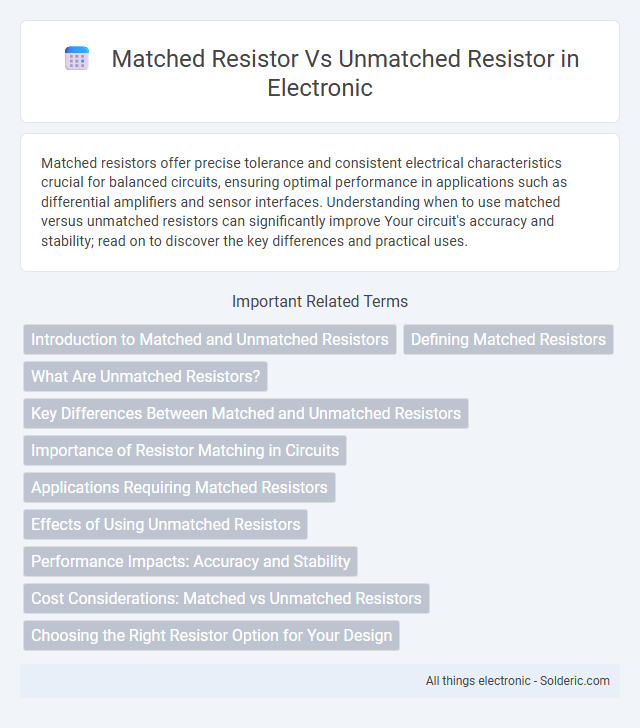Matched resistors offer precise tolerance and consistent electrical characteristics crucial for balanced circuits, ensuring optimal performance in applications such as differential amplifiers and sensor interfaces. Understanding when to use matched versus unmatched resistors can significantly improve Your circuit's accuracy and stability; read on to discover the key differences and practical uses.
Comparison Table
| Feature | Matched Resistor | Unmatched Resistor |
|---|---|---|
| Definition | Resistors with identical resistance values and specifications | Resistors with varying resistance values and tolerances |
| Resistance Tolerance | Very tight tolerance (e.g., +-0.1% or better) | Standard tolerance (e.g., +-1% to +-5%) |
| Application | Precision circuits, sensor bridges, calibration | General-purpose, non-critical circuits |
| Performance | Minimizes imbalance and improves accuracy | Potential for mismatch-induced errors |
| Cost | Higher cost due to tighter specifications | Lower cost, widely available |
| Example Use | Wheatstone bridge, differential amplifiers | Basic voltage divider, load resistors |
Introduction to Matched and Unmatched Resistors
Matched resistors exhibit nearly identical resistance values and temperature coefficients, ensuring consistent performance in precision circuits such as differential amplifiers and sensor interfaces. Unmatched resistors lack this closely controlled pairing, which can lead to variations in voltage or current distribution, potentially impacting the accuracy and stability of your electronic designs. Choosing matched resistors is crucial when signal integrity and minimal offset errors are essential.
Defining Matched Resistors
Matched resistors are pairs or sets of resistors designed to exhibit nearly identical resistance values, temperature coefficients, and tolerance levels to ensure minimal variation in electrical performance. These resistors are crucial in precision circuits for applications like differential amplifier inputs or bridge circuits where balanced resistance affects accuracy. Unmatched resistors, by contrast, have independently specified values and tolerances without guaranteed pairing, leading to greater variability in circuit behavior.
What Are Unmatched Resistors?
Unmatched resistors are resistors with resistance values that vary beyond a specified tolerance range, causing inconsistencies in circuit performance. These resistors can lead to imbalanced signal processing, increased noise, and reduced accuracy in sensitive electronic applications. Unlike matched resistors, unmatched resistors do not guarantee uniformity in electrical characteristics, making them less suitable for precision circuits.
Key Differences Between Matched and Unmatched Resistors
Matched resistors exhibit nearly identical resistance values and temperature coefficients, ensuring consistent performance in precision circuits such as differential amplifiers. Unmatched resistors have varying resistance tolerances and can introduce asymmetry, leading to measurement errors or instability in sensitive applications. The critical difference lies in the level of resistance uniformity, which impacts circuit accuracy and noise reduction capabilities.
Importance of Resistor Matching in Circuits
Resistor matching is critical in circuits where precision and consistency directly impact performance, such as in differential amplifiers and voltage dividers. Matched resistors ensure identical resistance values, minimizing errors caused by resistance variation and enhancing signal integrity. Unmatched resistors can introduce imbalance, resulting in offset voltages, increased noise, and degraded circuit accuracy.
Applications Requiring Matched Resistors
Applications requiring matched resistors often include precision analog circuits, such as differential amplifiers, instrumentation amplifiers, and bridge circuits, where resistor tolerance directly affects accuracy. Matched resistors ensure minimal offset voltage and improved temperature stability, providing consistent performance in sensor signal conditioning and balanced signal processing. Using matched resistors in your design enhances measurement precision and reduces error in critical applications.
Effects of Using Unmatched Resistors
Using unmatched resistors in a circuit can lead to signal imbalance, increased noise, and distortion, which negatively impacts overall performance and accuracy. Mismatched resistors may cause uneven current flow, resulting in voltage offsets and reduced common-mode rejection ratio (CMRR) in differential amplifiers. In precision applications such as sensor interfaces and analog signal processing, unmatched resistors degrade measurement reliability and increase error margins.
Performance Impacts: Accuracy and Stability
Matched resistors offer superior accuracy and stability by maintaining consistent resistance values across temperature changes and time, reducing signal distortion and noise in precision circuits. Unmatched resistors can cause variations in voltage and current, leading to decreased performance and potential errors in sensitive applications. Your circuit's overall reliability improves significantly with matched resistors, ensuring consistent and predictable results.
Cost Considerations: Matched vs Unmatched Resistors
Matched resistors typically cost more than unmatched resistors due to the precision manufacturing and testing required to ensure identical resistance values within tight tolerances. Unmatched resistors are less expensive and suitable for applications where exact resistance matching is not critical, offering a cost-effective solution for general use. Your choice between matched and unmatched resistors should consider the balance between budget constraints and the necessity for precise resistance in your circuit design.
Choosing the Right Resistor Option for Your Design
Choosing matched resistors ensures consistent resistance values, improving signal integrity and minimizing noise in precision circuits. Unmatched resistors are suitable for general applications where exact resistance matching is less critical, offering cost savings and design flexibility. Evaluating circuit requirements for accuracy, tolerance, and environmental stability guides the optimal resistor selection for your design.
Matched resistor vs unmatched resistor Infographic

 solderic.com
solderic.com